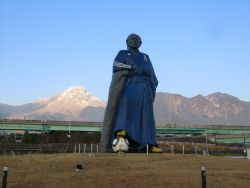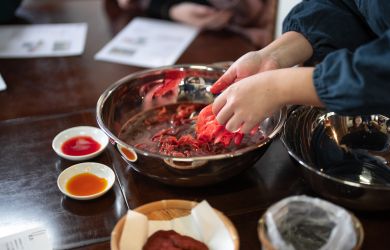
December 3, 2009
Danshui
The historical town is a short ride from Taipei—and a world away
By Metropolis
Originally published on metropolis.co.jp on December 2009

http://www.flickr.com/photos/koadmunkee/ / CC BY 2.0
Photo by koadmunkee on Flickr. Used under Creative Commons License (CC BY 2.0)
As the train rolls out beyond the northwest suburbs of Taipei, the tower blocks and freeways give way to paddy fields and small farmsteads, and the iconic Taipei 101 skyscraper slowly diminishes in scale. At more than 500 meters tall, it’s still visible until shortly before the train pulls into Danshui station, the last stop on the line. Once it has disappeared, though, you know that you have well and truly left the hubbub of the Taiwanese capital behind.
Danshui used to be an important fishing port, strategically placed at the mouth of the river from which it takes its name. That river has since largely silted up, however, and the people of this pleasant town now make their living primarily off day-trippers from the capital. And while it may get busy at the weekend and on national holidays, a visit on a weekday can be a pleasant escape.
A long stone wharf fronts the river, with skiffs pulled up on the flats, where the occasional wading egret probes the mud. Small shops selling ice cream, grilled squid and fish balls sit alongside others selling tourist trinkets, game arcades and massage parlors staffed by blind people.
The Danshui River is crisscrossed by ferries to the southern bank and the town of Bali. Green mussels are a local favorite at Fisherman’s Wharf and the shopping street beyond, which quickly rises to the pyramidical hill known as Guanyinshan, its flanks dotted by apartment complexes and, higher up, the occasional temple.
Back on the north shore, the number of visitors declines as the wharf narrows from a road to a path, but just where it looks as if you are entering a residential district, you’ll find the Waterfront bar and cafe (www.waterfronttw.com). At this oasis of rattan chairs, shaded courtyards and thatched cottages overlooking the river, a Taiwan Beer costs about ¥400 and the fried fish with lemon cream sauce is a steal at ¥1,300.
A leisurely stroll along Zhongcheng Road as it leads out of town to the north is a good way to walk off lunch, as well as that second beer. About a kilometer along the river are two historical sights that underline the former importance of Danshui.
Huwei Fort was built after the Sino-French war of 1886 to protect the mouth of the river. It was solidly constructed—the walls are more than 4m thick and stand 7m tall. From the parapets, four batteries still give excellent views out to sea. Beside the fort sits the Martyr’s Shrine, which was originally built by the occupying Japanese in 1939 but renovated after Taiwan’s liberation and given a distinctly Chinese design—before being dedicated to all those who had fought the Japanese occupiers.
Nearby, Fort San Domingo is Danshui’s most famous sight, perched atop a hill that has been fortified since the Spanish first landed in northern Taiwan in the 1620s. The British took over the fort in 1868, turning it into their consulate and building a consular residence next door. The interiors have been well preserved, with all the trappings of the British Empire: ceiling fans, teacups and overstuffed armchairs.
The busiest part of Danshui is the portion of Zongcheng Road that runs parallel to the riverfront. Antiques shops stand beside knickknack emporiums, shrines and numerous kiosks selling snacks. Fuyou Temple is a riot of red and gold decorations, lanterns and incense, attracting a steady stream of locals to pay their respects. To the south, the Qing Dynasty era Yinshan Temple is a protected national treasure, considered to be the best-preserved example of its kind in the country.
Heading back towards the station, Taiwanese day-trippers apparently think in very much the same way as Japanese tourists: must take a local delicacy back for friends and family. With that in mind, don’t leave town without visiting “Grandma’s Iron Eggs,” “Kekou Fish Balls” or “Syu Yi Fish Crisps.”
All Nippon Airways flies twice daily from Tokyo Narita to Taipei, departing at 9:20am and 6:20pm (www.ana.co.jp/eng). From Taipei, the easiest way to Danshui is on the Danshui MRT Line, a 35-minute journey that costs NT$50 (¥135). Huwei Fort costs NT$25 (¥68) to enter and Fort San Domingo is NT$30 (¥81). Most visitors return to Taipei after a visit to the coast, but the Joy Hotel Danshui on the coast north of the town is a good place to stay, and has rooms from US$69 per night. A tourist information office in the station has plenty of information in English, while the Lonely Planet guide to Taiwan is also helpful.
[geo_mashup_map]





